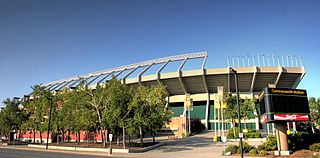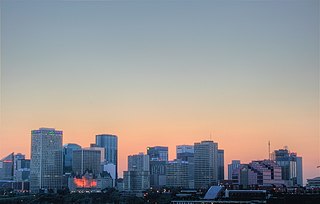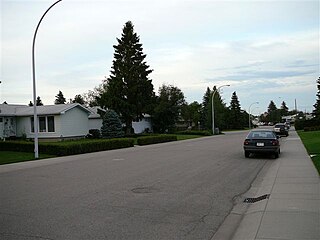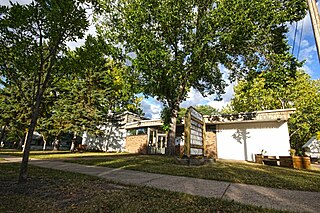Bonnie Doon is a neighbourhood in south-central Edmonton, Alberta, Canada. The well-known Mill Creek Ravine Park forms its west boundary. The Bonnie Doon shopping mall is on its east boundary.

McKernan/Belgravia station is an Edmonton LRT station in Edmonton, Alberta. It is served by the Capital Line, and is the least used station on the LRT system. It is a ground-level station located on 114 Street at 76 Avenue.

Downtown Edmonton is the central business district of Edmonton, Alberta. Located at the geographical centre of the city, the downtown area is bounded by 109 Street to the west, 105 Avenue to the north, 97 Street to the east, 97 Avenue and Rossdale Road to the south, and the North Saskatchewan River to the southeast.

McCauley is an ethnically diverse inner city neighbourhood in Edmonton, Alberta, undergoing revitalization. It is named for Matthew McCauley, the first mayor of Edmonton, and is located just to the north east of the Downtown core. McCauley is known as the home of religious buildings in a small area, as well as being a large venue for the 1978 Commonwealth Games.

Belgravia is a residential neighbourhood located in Edmonton, Alberta. It is located southwest of the University of Alberta main campus. Named after the Belgravia area of 19th-century London, the neighbourhood was once the southern terminus of the Edmonton Radial Railway. The McKernan/Belgravia LRT Station is located adjacent to the neighbourhood at the northwest corner of 114 Street and 76 Avenue in neighbouring McKernan.

Strathearn is a roughly triangular shaped residential neighbourhood in south central Edmonton, Alberta, Canada. Most of the development in Strathearn dates to the 1940s and 1950s.
Windsor Park is a south central neighbourhood in the City of Edmonton, Alberta, Canada. It is located immediately to the west of the University of Alberta north campus and overlooking the North Saskatchewan River valley to the north, west, and south west. It shares a short boundary with the neighbourhood of Belgravia to the south.

Garneau is one of the oldest neighbourhoods in the city of Edmonton, Canada. Prior to 1912, it was part of the City of Strathcona. It is named after one of its first inhabitants, Laurent Garneau, a former Manitoba Métis rebel and Hudson's Bay Company employee who with his wife and family settled there around 1874.

Lynnwood is a residential neighbourhood in west Edmonton, Alberta, Canada. It is near downtown, the University of Alberta, MacEwan College, and West Edmonton Mall. It became a part of Edmonton when the Town of Jasper Place amalgamated with Edmonton in 1964.
Parkallen is a residential neighbourhood in south Edmonton, Alberta, Canada located just to the east of the University of Alberta farm and the Neil Crawford Centre. Most of the neighbourhood development occurred after the end of World War II with eight out of ten residences constructed by 1960 according to the 2005 municipal census.
Strathcona is a residential neighbourhood in south central Edmonton, Alberta, Canada. It is a part of, and should not be confused with, Old Strathcona, although much of the Strathcona neighbourhood is in Old Strathcona. The neighbourhood overlooks both the North Saskatchewan River and the Mill Creek Ravine.
Duggan is a residential neighbourhood in south Edmonton, Alberta, Canada. The neighbourhood is "named for John Joseph Duggan (1868-1952), an early businessman and mayor of the town of Strathcona and the City of Strathcona. He is remembered by the Duggan House on Saskatchewan Drive, the Duggan School and the Duggan Bridge.
Allendale is a residential neighbourhood located in south west Edmonton, Alberta, Canada. The neighbourhood is named for the Allen family, who owned a farm there. It was annexed by the City of Strathcona in 1907.
Bellevue is a smaller residential neighbourhood located in north east Edmonton, Alberta, Canada. The neighbourhood overlooks the North Saskatchewan River.

Ritchie is a residential neighbourhood in south east Edmonton, Alberta, Canada. It is named for Robert Ritchie, the original owner of the Ritchie Mill and former mayor of the City of Strathcona. The population of Ritchie enjoy good access to the nightlife of nearby Old Strathcona and the Mill Creek Ravine.
King Edward Park is a residential neighbourhood on south east Edmonton, Alberta, Canada. The neighbourhood was originally annexed by Edmonton in 1912.
University Avenue is a discontinuous street in Edmonton, Alberta, Canada, partially an arterial road and partially a residential street. It was established in the 19th century along the south edge of a series of farm lots west of the yet-to-be-incorporated town of Strathcona, causing it to run parallel with the North Saskatchewan River to the north. The farm lots later became the University of Alberta campus, which was established in 1908. In the mid 20th century, University Avenue was permanently segmented as part of traffic calming measures, including disconnecting the eastern section with 114 Street, extending Joe Morris Park, and extending the grounds of Our Lady of Mount Carmel school.

The Strathcona Library, one of the oldest libraries in Alberta, completed in 1913, was the first library erected in the City of Edmonton. Nevertheless, the Strathcona Library does have a complex background as to its historical status within the Edmonton Public Library system. It is located on 104th Street, a block off of Whyte Avenue in the heart of Old Strathcona. Situated next to Wilbert McIntyre Park, the iconic Old Strathcona Gazebo, and the year-round Old Strathcona Farmer's Market, the Strathcona Library is often a central gathering area for much of the local community. During the annual Edmonton International Fringe Festival in the surrounding area, the Strathcona Library often hosts a large booksale to help shift aging and excess material from Edmonton Public Library's circulation.










